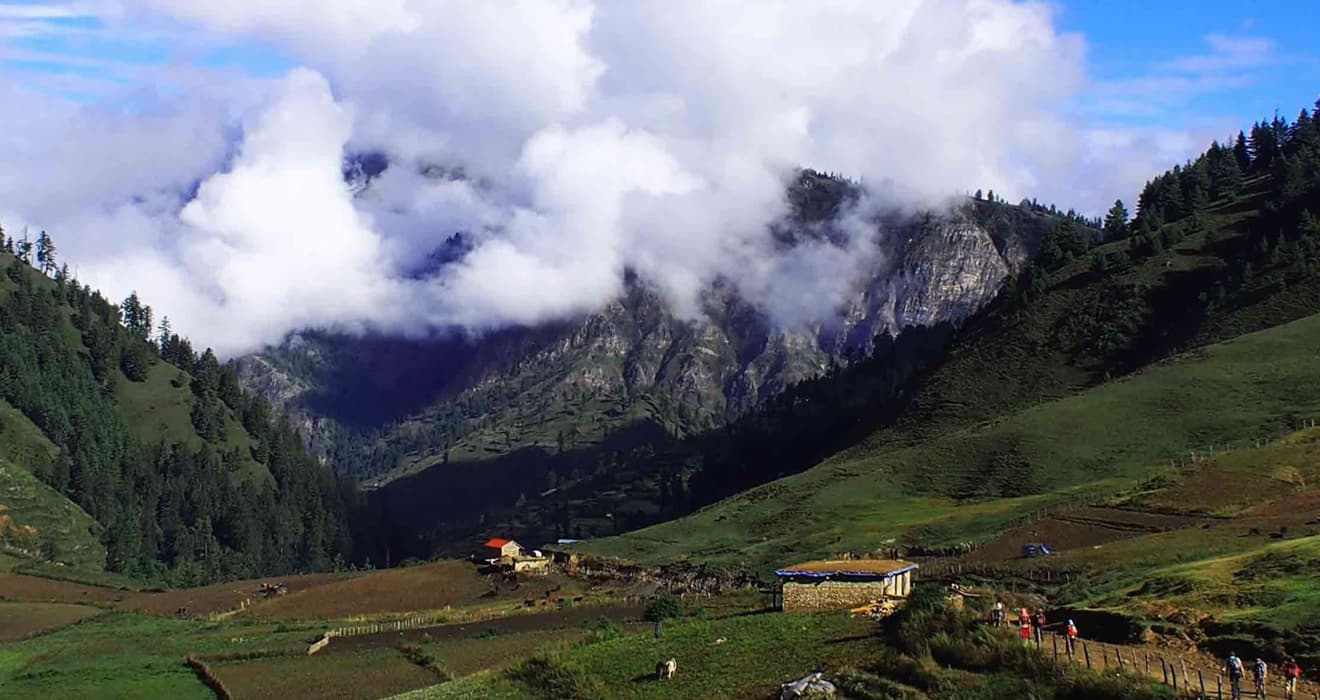- What is the Kanchenjunga Trekking?
- How difficult is the Kanchenjunga Trekking?
- What natural terrain is the Kanchenjunga Trekking composed of?
- The Kanchenjunga Peak
- The Kanchenjunga Conservation Area
- The Thriving Sherpa, Rai and Limbu Ethnic Culture Experience of the Kanchenjunga Trek
- The Kanchenjunga North Base Camp
Nepal is truly a cornucopia of natural, Himalayan and cultural wonders. The country is ornamented with many diverse features that vary according to the location, geomorphology of the land, the topography and the elevation. It is a beautiful amalgamation of hallmarks that are unique and present distinct trekking experiences. As such, Kanchenjunga Trekking is one of the most amazing adventures in the world. Not only does trekking in Nepal present the opportunity to enjoy a Himalayan landscape unlike anything else on the planet, but it also gives visitors of the country a chance to closely observe the ethnical aspects of Nepal's multicultural spectrum.
There is definitely something for people of all preferences here in terms of trekking. From treks with varying difficulty levels and time durations to popularity and destination, Nepal Treks present a wide variance of choices. In such context, off-the-beaten-paths treks are often the choice for trekkers who are looking for less-crowded and relatively lesser known journeys. Off-the-beaten-paths treks are often not immediately chosen- or to put it another way- have a feel of isolation, which makes trekking on such ventures an experience of new discoveries and authentic and relatively untouched experience of the nature and cultural features of said locations. Likewise, among the many off-the-beaten-path treks in Nepal, perhaps the most beautiful is the Kanchenjunga Base Camp Trek.
What is the Kanchenjunga Trekking?
One of the most authentic and unspoiled of trekking adventures of Nepal, the Kanchenjunga Trekking is a journey that takes trekkers deep into the remote mountain ranges that border Nepal, Sikkim and Tibet. It is considered one of the best rural trekking adventures in Nepal that, most often than not, circuits around the country's eastern region. The Kanchenjunga region is among the most remote regions of Nepal. Specifically, the Kanchenjunga Trek takes trekkers through the Kanchenjunga Conservation Area, and the region is named after Mount Kanchenjunga- the world's third highest Himalayan peak and the second highest Himalayan peak of Nepal. The trek occurs in the northeastern corner of Nepal near Sikkim in the Taplejung district of the country.
How difficult is the Kanchenjunga Trekking?
Due to the winding trails of the Kanchenjunga Trek that go through High Mountain passes and reaching elevations of 5,150 meters- the journey is categorized as a moderately strenuous trip. Although no previous trekking experience is necessarily required to do this trip, it does get a bit rough at certain destinations, but nothing that cannot be overcome with patience and proper acclimatization. Usually, the Kanchenjunga Trek has duration of about more than 3 weeks, and takes 24 to 26 days to complete. It goes through rural villages and far-off settlements of the Taplejung district, like the villages of Mitlung, Chirwa, Ghunsa and Sele Le among many others.
What natural terrain is the Kanchenjunga Trekking composed of?
As said, the Kanchenjunga Trekking takes place in the Taplejung district, right on the border area of Nepal with Sikkim and Tibet. While trekking, the trail coruscates around the region's trans-Himalayan landscape. Most of the trek takes place in the Kanchenjunga Conservation Area, a protected site of Nepal with an area of 2,035 km2. The trekking trail gorgeously winds through one of the most untouched and beautifully preserved natural terrains in Nepal, with the journey ebbing along the flourishing cultivated fields, verdantly emerald pastures, lush rhododendron woods and scented deciduous forests of pine, juniper and cedar all shadowed by the majestic Kanchenjunga Peak. The natural terrain of the Kanchenjunga Trek is mainly composed of amazing upper alpine meadows, moist alpine scrubs, large areas of Fir and Larch forests, mixed rhododendron and maple woodlands and jaded oaks and laurel acreages.
Highlights of the Kanchenjunga Trekking-
The Kanchenjunga Trek, due to its isolation and off-the-beaten-paths nature, has managed to retain most of its authentic ambiance. As a result, the trekking journey presents the most regal unsullied natural landscapes and cultural highlights. Here are some of the best highlights of the Kanchenjunga Trek-
The Kanchenjunga Peak
As mentioned, the Kanchenjunga Peak is the third highest mountain in the world. It has five distinct peaks, three of which are situated directly in the border between Nepal and India and two, namely the Kanchenjunga West and Kangbachen in Nepal's Taplejung. The peak gets its name derived from Tibetan origins, with "Kanchenjunga" meaning "the five treasures of the high snow" referring to its five peaks. The mountain is considered as sacred and is also worshipped by the ethnic Limbu people of the district. In the Limbu language, the peak is called Senjelungma, and it is believed to be an abode of the omnipotent Limbu goddess- Yuma Samman, a supreme divinity of power, wealth and wisdom. While trekking, the Kanchenjunga peaks shadow the valleys of the district and along with the Jannu Peak and other neighboring Himalayas, the Kanchenjunga Trek harbors a serene Himalayan atmosphere unlike anything else in the country.
The Kanchenjunga Conservation Area
Established in 1997 as a conservation area adjoining the Qomolongma Nature Preserve in Tibet and the Kanchenjunga Biosphere in Sikkim, the Kanchenjunga Conservation Area is one of the best highlights of the Kanchenjunga Trek. As a matter of fact, the area was declared as "Gift to the Earth" by World Wildlife Foundation. The protected area also comprises of the two of the five peaks of Kanchenjunga and is home to several species of endangered animals like Snow Leopards, the Asiatic Black Bears, and Red pandas. With the inclusion of the Kanchenjunga Conservation Area, Nepal became Asia’s third country, after Bhutan and Cambodia, to include over 18% of its total land under the protected area system. In addition to the endangered floral and faunal treasures, the conservation area is also home to a population of 5,000, 48% of which are Limbu and 25% Sherpa ethnicities among other minors as well.
The Thriving Sherpa, Rai and Limbu Ethnic Culture Experience of the Kanchenjunga Trek
The Kanchenjunga region where the trek takes place presents a cultural experience as well as a natural one. In majority, the region is mainly occupied by the Rai and Limbu ethnic people, as well as Sherpa communities. Due to the sporadic nature of the region and its relative isolation, the households are highly scattered, with only a few households in close clusters as settlements and small villages. While undergoing the Kanchenjunga Trek, you will find that most of the ethnic people of the region are involved in agriculture. Trekkers can also sometimes experience shamanic rituals and practices performed by the ethnic people. Since the Limbu people of the region worship the Kanchenjunga Peak and believe it to be the abode of an omnipotent goddess, there are rituals that involve ceremonies dedicated towards the Kanchenjunga Peak. Verdant hills brimming with agricultural pastures and protected with malingo mats made of bamboo are a common sight while trekking.
Similarly, two major domesticated livestock are managed by the village people, which are strongly linked to the ethnicity of the communities. The Limbus and Rais in destinations like Yasang, Lawajin, and Langluwa hold at least one or two cows, goats, sheep or pigs for subsistence purposes, and which form an integrated part of their farming system. The Sherpas, however, have chauris (crossbreed of yak and cattle) in larger herds, and their dairy production (milk, churpi, and ghee) are a major source of cash income. While trekking, kharkas are also common sights at high pastures; communities have a tradition of keeping their livestock in what is traditionally called kharkas, which are common grazing areas. At the time while trekking, the trail passes alongside these kharkas that sometimes hold hundreds of livestock grazing contentedly in the fields.
The Kanchenjunga North Base Camp
Located at an elevation of 5,388 meters, the Kanchenjunga North Base Camp is the highest point of the Kanchenjunga Trek. The north face base camp of the Kanchenjunga Peak is situated at Pangpema (5,100). While trekking, it is reached by a high track following the moraine of the Kanchenjunga Glacier. Located above the glacier, the base camp offers stunning views of the north face of Kanchenjunga and the Yalung Kang (8,505m) as well as Mount Jannu.
Consequently, the Kanchenjunga Trekking is a diverse and isolated trekking journey that is a beautiful trip in the far-off region of Nepal. It is unsullied and presents untouched cultural and natural features that are difficult to find in popular treks like the Everest Base Camp Trek for example. The journey is filled with charismatic landscapes that are shadowed by the towering peaks and wide open fields of sparse settlements. It is an authentic trek that presents the best rural countryside life of Nepal's alienated Himalaya. Thus, the Kanchenjunga Trekking is one of the best off-the-beaten-paths treks in Nepal that you simply must do once in life!



